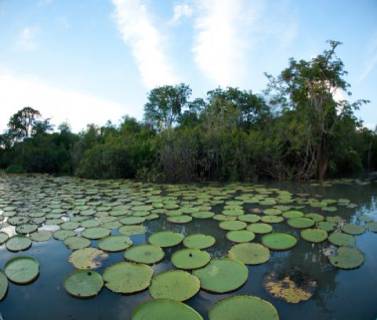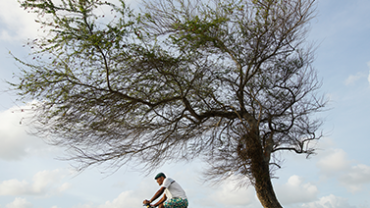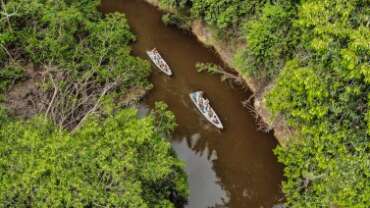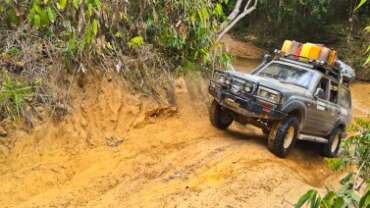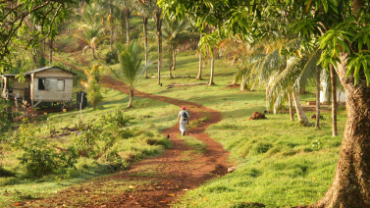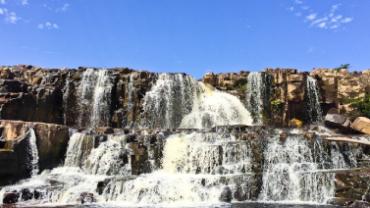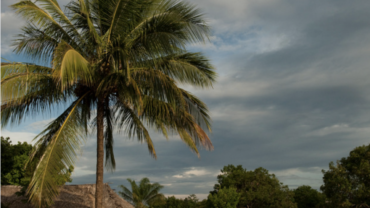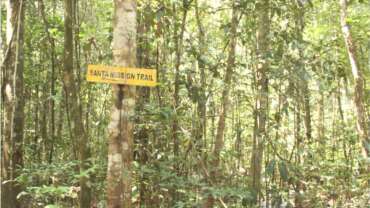Experiences in Guyana
Birding
An estimated 80% of Guyana’s primary rainforest remains intact and is complemented by a rich diversity of habitats such as savannah grasslands, mangrove forests and coastal wetlands. Together, they are a thriving habitat for birdlife. Guyana is blessed to have species that are not overly difficult to see such as the Harpy and Crested Eagles, Guianan cock-of-the-rock, Sun Parakeet, and the colourful Hoatzin, Guyana’s glamorous national bird and directly related to the archaeopteryx, the first known bird.
Culture & Heritage
With a vast mix of ethnic backgrounds, traditions, spiritual beliefs, festivals, architecture and landscapes, the memories of Guyana blaze long after travellers have left its shores. The rich cultural landscape of the country can best be explained as a mix of Caribbean culture (found mostly on the coast) and Indigenous roots (found more south in the country), with a dash of its colonial legacy which brought many other nationalities to live in Guyana. It can be experienced by attending festivals, staying with local communities in ecolodges, exploring the architectural heritage of the country, and indulging in Guyanese cuisine.
Culinary Traditions
Abundantly fertile and blessed with year-round tropical weather, Guyana is rich in local foods and known for its exotic fruits, fresh vegetables and grains, free-range chicken and beef, and diversity of fish species.
Guyana is a melting pot of culture, and you can truly see that in the local cuisine. Traditional Guyanese cuisine is inspired by the Indigenous Peoples, who have always lived off of the abundance of the land. Other influences stem from East Indians, Africans, and Chinese, colonial occupiers like the British and Dutch, and the neighboring Caribbean nations.
Local Dishes
Cassava, split peas and lime are some of the most popular ingredients used in local Guyanese dishes. Cassava bread is a staple in Indigenous Communities and is often paired with pepper pot (often hailed as the ‘national dish of Guyana’), meat curries and vegetables. In Indian households, brown rice and dhal (a gravy dish made with split peas) are popularly served with masala-based curries and stewed local vegetables. The African community is well known for its contribution of cook-up rice, conke and foo foo. The European settlers’ contribution of garlic pork and a variety of pastries is now a staple in the Guyanese diet. Cassava pone, pholourie, metemgee, farine based dishes, fried bora, salt fish and bake, fish cake and Indian bara are some of the other local dishes to try in Guyana.
Street Food & Snacks
Caribbean, Asian and South America flavours merge together to offer a diverse menu of street food and snacks in the country. Split pea fritters called pholourie are one of the most popular street snacks available in markets. Chinese style noodles, Indian inspired bara, Guyanese fudge, sugar cake made from local cane sugar and coconut, egg balls and plantain chips are other popular options for a perfect snack when strolling in the market or shopping.
Fine Dining & Evening Hangouts
Georgetown has a vibrant dining culture. It has an ample variety of local and international cuisines that entice locals and travellers alike. From plush restaurants to casual dining options, there are plenty of restaurants and bars in Georgetown that make hanging out during the evening fun. While outside of Georgetown, you will have to seek out recommendations for great dining experiences. Your efforts will be rewarded with local spots that will likely be the culinary highlight of your trip.
Guyana Restaurant Week
A designated week to honour the diversity of food in Guyana gave birth to Guyana Restaurant Week, which is celebrated two times a year. In May and November, participating restaurants notch up their offerings and showcase their best dishes. This is the best time to get deals and discounts and enjoy a whole week of eating out, sampling excellent dishes and the rich variety of cuisine.
Built Heritage
The heritage of Guyana is a combination of great local architecture, colonial, remnants, history, modern political movements, and the living culture of its diverse population. The net result is that the built heritage of Guyana is a riveting hook for travellers. The wooden churches with stained glass features, museums with,Demerara windows, Dutch sluice and canal engineering in Georgetown and a number of other historical structures in the country offer a window into the country’s past and present. The National Trust of Guyana is the leading organisation responsible for the preservation and restoration of the colonial buildings and historical sites found throughout Guyana.
National Art Gallery
The 19th century relic in the heart of Georgetown was once known as Castellani House, named after the designer of this impressive building. Ceaser Castellani was one of the most talented architects in British Guiana in the mid-1800s. This was
originally designed as a residence for the government botanist, George Samuel Jenman, but later became the Official Residence for Prime Minister Forbes Burnham. It reopened in 1993 as the National Gallery with more than 700 works of art from all over the world.
Main Street Avenue
The prominent Main Street Avenue in Georgetown is a cultural relic of the city for many reasons. The 1909 built National Library, Bank of Guyana, the Walter Roth Museum, the Prime Minister’s House and War Memorial stand on this street. It was also the venue for Queen Elizabeth’s coronation in June 1953, and still remains the main path for any parade and national celebration. While one side of the avenue is dotted with distinguished addresses, the other has a vibrant atmosphere with many restaurants, nightlife spots, and local vendors selling their art. The Main Street Avenue is a vivid representation of Guyana’s past and present.
Arts & Crafts
Hibiscus Plaza
Looking for a great local handicraft souvenir from Guyana? Head straight to Hibiscus Plaza, the street market in the heart of the city. Cosy shops packed with hand-made leather, cane, balata and cloth goods are great for those on a bargain hunt. Curios, bags, containers, jewellery and even the typical South American cloth hammocks are some of the best souvenirs from Guyana.
Conservation Travel
Conservation Travel in Guyana
Guyana’s rich biodiversity, dramatic landscapes, and friendly, Indigenous Peoples provide a dazzling diversity of experiences in nature. Together with visionary community leaders and tour operators, a new form of conservation tourism has evolved from ecotourism. Conservation travel makes a net positive contribution to the conservation of biological diversity and ecosystem services.
The country took its first steps towards pioneering conservation travel under the leadership of the legendary Diane McTurk. Diane grew up on a cattle ranch in Karanambu in the Rupununi. Here, she laid the groundwork for using tourism and conservation practices to offer visitors delightful experiences in the jungle and savannahs as well put relentless efforts towards restoring and preserving the natural ecosystems on the ranch. Her work in helping to save and protect giant river otters set a high benchmark for conservationists and researchers all over the world.
Diane and indigenous visionaries like Fred Allicock influenced numerous indigenous communities to establish community conservation areas to protect birding and wildlife habitat for visitors to enjoy. Your visit to these communities not only supports the protection of nature and wildlife but also the maintenance of ancient traditional practices.
Conservation Tourism Experience
There are a number of world-class experiences from donor and government-led projects like the EU-supported Guyana Mangrove Restoration Project that resulted in two new community tourism experiences in Victoria and Mahaica to community-led initiatives like Rewa’s, Yupakari and Surama’s efforts to protect rainforest ecosystems for wildlife tourism. Others include Apoteri and Rewa’s efforts to protect river ecosystems and tribal fishing grounds for catch and release sport fishing, and the South Rupununi Conservation Society’s efforts involving six villages who are protecting the endangered Red Siskin. These tourism initiatives provide economic incentives to host communities to make a net positive contribution to the conservation of biological diversity within the lands they manage.
SAVE Travel in Guyana
An increasing number of visitors coming to Guyana seek out learning opportunities and close interaction with the nature, culture and local people to create positive impacts and lifelong bonds. The sustainable management of natural resources and sustainable development of Guyana is of vital interest to the SAVE travel market. SAVE stands for the Scientific, Academic, Volunteer and Educational travelers who want to visit Guyana. SAVE travel is driven by the desire to advance knowledge and contribute to the enhancement of the host country.
Guyana’s Extraordinary Research Potential
Guyana is a vital refuge for wildlife. This vast expanse is one of the last great tropical wilderness areas. Wildlife is abundant in many of the remote parts of the country largely due to its intact forests and difficult access. Guyana takes its moniker of ‘Land of the giants’ seriously and boasts more than 228 mammals, 820 species of birds, 800 fish, and 1000 tree species, many of them found nowhere else. Some of the world’s most iconic wildlife – jaguars, harpy eagles, arapaima, giant anteaters, giant river otters, tapir, and more – still thrive in this interconnected ecosystem of tropical rainforest, massive savannahs, and expansive river systems.
Diverse Landscapes
Guyana is an ancient and enchanting place to conduct fieldwork. In the age of overtourism, the country remains unvisited by many outsiders, despite having some of the most intact and spectacular natural landscapes in South America. More than 80% of the country’s vegetation remains in a natural state. Nine indigenous groups have occupied Guyana’s interior regions for thousands of years, stewarding the ecosystems that sustain them. Coastal mangroves, sprawling savannahs and untainted rainforests, along with mountain ranges and highlands covered in isolated tepuis, make up the country’s rich topography. These wild expanses inspire the adventurer in scientists and volunteers alike.
Protected Areas & Forest Reserves
Protected Areas currently cover approximately 8.5% of the country’s landmass. Amongst the main areas to explore in Guyana, Iwokrama Rainforest Reserve, Kaieteur National Park (link), Konashen Community-Owned Conservation Area, Kanuku Mountains and Shell Beach are the most popular. The National Park, Botanical Gardens and Zoological Park in Georgetown are much more accessible and serve as the lungs of the city. There are also a number of Forest Reserves, several offer research facilities and are relatively accessible.
Savannahs
The sprawling grasslands of Guyana cover the belly and some southern parts of the country, offering a dramatic change of scene from thick rainforests, the vast ocean and mountains of the north and deep south. There is ample for the eyes and the soul for the travellers. The flat pale-yellow grasslands allow easy spotting of a range of animals, especially the anteaters. Unique avian species that like a combination of grasslands and canopies exist in the Rupununi, making it a birding hotspot. The ranching culture in the savannahs is starkly different from the Caribbean vibe of the north, with rodeo events headlining the region.
North Rupununi
North Rupununi offers many travellers their first glimpse of the incredible untouched rainforests of Guyana and is one of the top places to visit in the country. You can hop between community-owned and operated eco-lodges located in rainforests, or find yourself in the middle of golden savannahs in a span of a few kilometres. Here, the pristine views, nature trails and village life compete for your attention at all times. The region is perfect to match your step to the slow village life; just make sure you are prepared for some serious hammock time between all of the adventurous activities!
THINGS TO DO
Stay at the Eco-Lodges
The iconic eco-lodges of North Rupununi make sure that you irreversibly fall in love with nature. Varied scenery and wildlife attractions accessible from each lodge gives you the chance to sample a few of them in a single trip. This way you can get a glimpse of different animals and birds specific to a particular lodge. For example, Karanambu Lodge offers a peek into the life of Diane McTurk, the legendary river otter conservationist, and a chance to see giant river otters and giant anteaters. Caiman House’s caiman tagging river trips are fascinating while Atta Lodge’s canopy walk is an essential for birdwatchers. Rockview Lodge and Pakaraima Mountain Inn offers views of the sprawling golden savannahs and Pakaraima mountains while Waikin Ranch engages travellers in the lifestyle of a vaquero. Surama and Rewa Eco-Lodges are hinged on community-led and owned tourism, where the villagers are in charge of and directly benefit from all tourism activities. More than anything else, the lodges are great learning grounds, both for amateur nature lovers or seasoned wildlife enthusiasts. A stay at any of these establishments promises a unique wildlife getaway and many offer immersive cultural experiences.
Village life in the Rupununi
Have you ever tried crunchy farine? It is a specialty indigenous dish made from cassava. What about sleeping in a hammock or fishing with a bow and arrow? If not, then this is your chance to check these off the list. You can experience local life in the villages as you bask in the essence of serene indigenous culture while staying in breezy benabs (thatched huts). Enjoy delicious local cuisine such as pepperpot and cassava bread, specially prepared by the people of Rupununi. Of course, you can add a little action with nature trails, hikes or just a swim in a creek to cool off. The villages of Rupununi are simple yet spectacular.
Birding & Wildlife
North Rupununi offers the ideal habitat for hundreds of species of birds and mammals, making it a top destination for nature enthusiasts. The thick rainforests criss-cross with trails that can be explored with a guide from one of the eco-lodges. Travellers can expect to see Macaws, Cotingas, Puff birds, Fruitcrows and Jacamars amongst other avian species. Amongst the mammals, jaguars, labbas, giant river otters, red howler monkeys and capybaras are prominent species that draw wildlife enthusiasts to the region.
South Rupununi
Wondering how to make the most out of your trip to Guyana? Then consider combining a visit to the North Rupununi with the distinctively different South Rupununi. The South Rupununi is less developed than the north, so fewer travellers venture here. Experience massive tracts of wilderness, vast savannahs, beautiful mountains, and authentic ranches. If you are lucky you may even catch a glimpse of some of the most exotic wildlife and birds that call the area home. These are just a few of the top reasons to visit here. Do not plan to rush through it, ‘slow and savour’ is the ideal way of exploring this region.
THINGS TO DO
Lethem and Around
Located at the border of Brazil, Lethem is home to the annual action during the Rupununi Rodeo weekend around Easter. The red laterite roads flanked with golden brown savannahs, massive termite hills and the surrounding Kanuku and Pakaraima Mountains make this a hard-to-resist landscape. Use Lethem as a jumping off point to explore working cattle ranches, community conservation areas, and Indigenous Villages. Giant anteaters, Red Siskins, anacondas and a host of other wildlife and birds, are just a few reasons why travellers cannot get enough of the region.
Sand Creek Rodeo
South Rupununi lies at the heart of Guyana’s ranch-life, where bull and horse riding are second nature to the locals. Rodeo events like Rupununi Rodeo and Sand Creek Rodeo transport travellers to the wild west as skilled vaqueros show off their tricks such as saddle bronc or bareback riding. Sand Creek Rodeo is a day-long event of cowboy hats and boots, beer drinking, and a host of other rodeo events that promise to enthral. It happens just a day after the Rupununi Rodeo, and is a great way to extend the weekend to watch more barrel racing, tie down roping and bull or horse riding.
Kumu Falls
Just a short drive away from Lethem, the indigenous village of Kumu is home to the eponymous falls that drop over 1520 feet. At the base of each section, natural jacuzzis offer the perfect setting to beat the tropical heat. The dry months are easy to navigate the falls, but in the monsoons, the water gushes down relentlessly. A traditional village style complex at the entrance is great for a cookout, hanging a hammock for a snooze, or lingering on for a picnic.
Skull and Bones Mountain
The first settlers, the Indigenous Peoples, discovered Guyana almost 35,000 years ago. These were cultivators, hunters, and fishermen who lived off the land – and still do. Traditional practices exist amongst these people who are well connected to their roots. Amongst some of the ancient practices is the burial tradition of leaving the dead in large earthen pots on top of hills. Skull and Bones Mountain is an ode to this practice. The hike starts from a thick copse at the base, and even though it isn’t a steep trek, one needs a guide with a machete to make their way through thick creepers and vines. On top, a cave houses large and small earthen pots with skulls and bones. This may be the main highlight, but the large array of flora comes in a close second.
Living the Ranch Life
Dust off that cowboy hat and your boots, and saddle up! This is going to be a ride (or trot, if you will) of a lifetime. Check-in at some of the oldest and most iconic working ranches in the Rupununi to experience life in a typical cattle farm. Saddle Mountain, Wichabai, and Dadanawa, which used to be the largest ranch in the world at one point of time, are a few of the best places to stay. The vast feeding grounds, vegetable gardens and cassava farmlands truly celebrate the Rupununi landscape. Riding into the sunset may be on your mind, but also be prepared to herd the cows back, clean them and feed the pigs and poultry. If none of that is up your alley, saddle up your horse and go for another memorable ride.
Konashen
In the deep South, Konashen Community-Owned Conservation Area offers the possibility of close encounters with wildlife and birds. This was the first community owned protected area in Guyana. With virgin forests and expansive savannahs, it is home to an astounding diversity and abundance of wildlife and pristine habitat. The rugged beauty and rustic charm of Rupununi is at full display here; so it is recommended you take in all the grand landscapes slowly and secure a guide to ensure that you get the necessary permission to visit.



